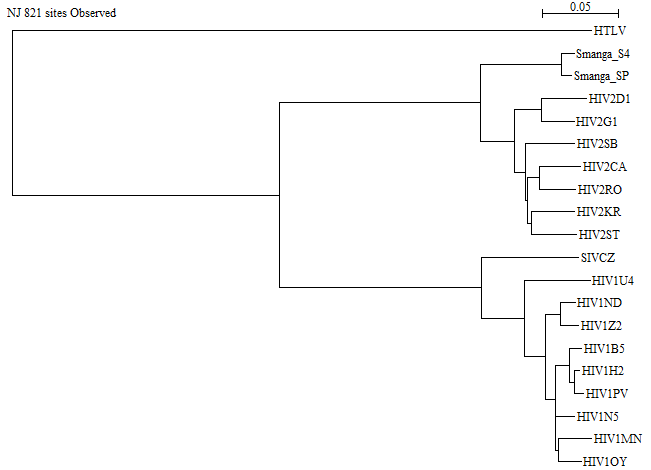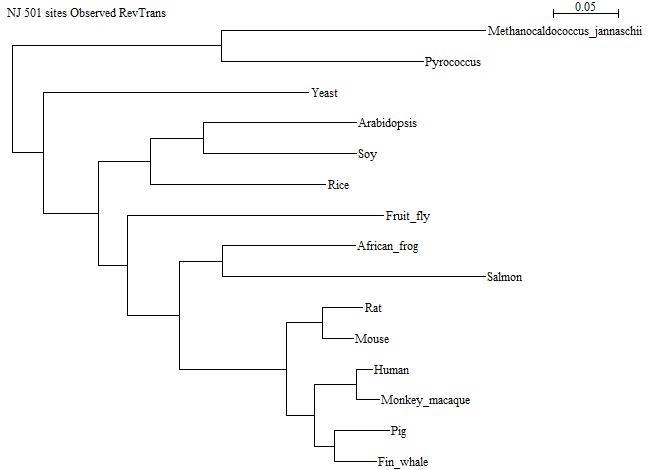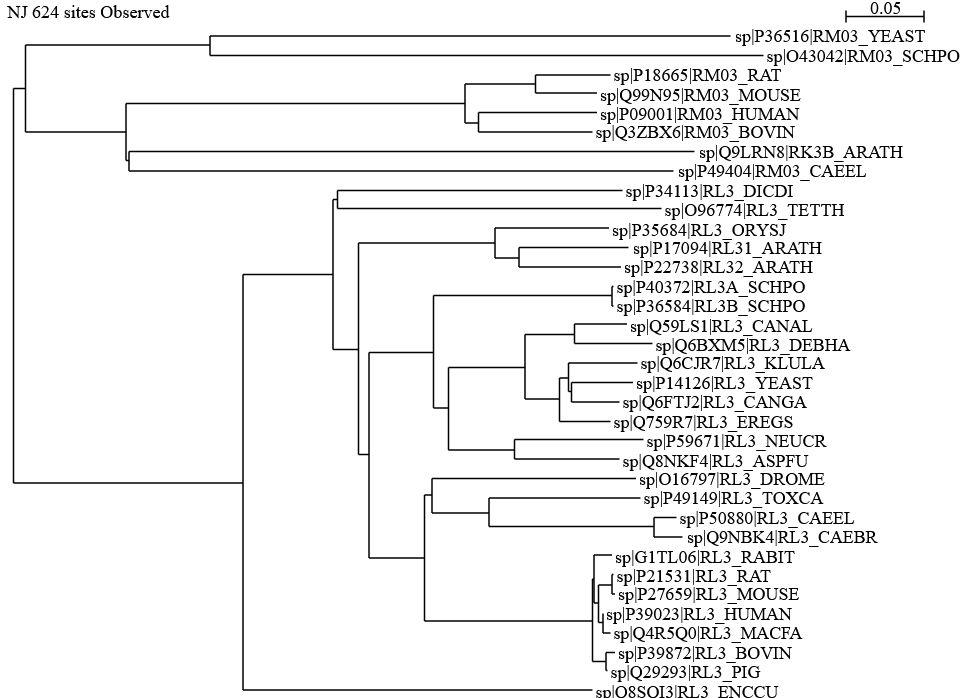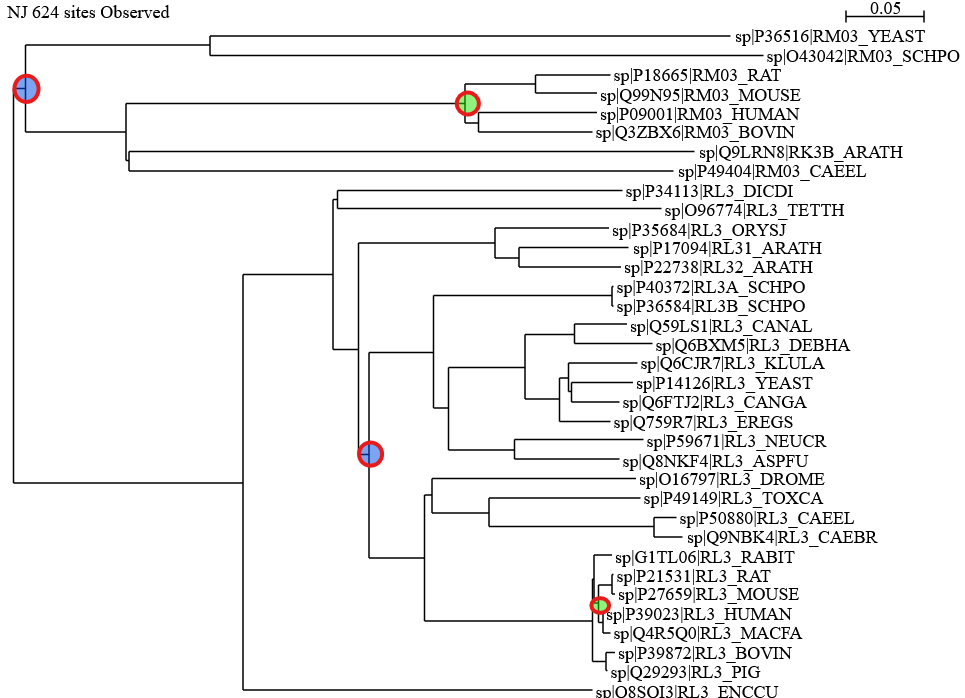Exercise: Phylogeny - Answers (Seaview version): Difference between revisions
(→Step 2) |
|||
| (13 intermediate revisions by 2 users not shown) | |||
| Line 241: | Line 241: | ||
* The sister group to the HIV1 sequences is SIVCZ (Chimpanzee SIV). | * The sister group to the HIV1 sequences is SIVCZ (Chimpanzee SIV). | ||
* The sister group to the HIV2 sequences is Smanga (Sooty Mangabey SIV). | * The sister group to the HIV2 sequences is Smanga (Sooty Mangabey SIV). | ||
* Further answers to "The Phylogeny of HIV" can be found [https://teaching.healthtech.dtu.dk/material/ | * Further answers to "The Phylogeny of HIV" can be found [https://teaching.healthtech.dtu.dk/material/22111/files/binfintro/hiv_origin.html here]. | ||
==Step 7== | ==Step 7== | ||
| Line 272: | Line 272: | ||
==Step 9== | ==Step 9== | ||
# | # 54 results. <br>Search string: <!-- <tt>name:"ribosomal protein l3" taxonomy:eukaryota fragment:no AND reviewed:yes</tt> --> <tt>(protein_name:"ribosomal protein l3") AND (taxonomy_id:2759) AND (fragment:false) AND (reviewed:true)</tt> | ||
# 8 and | # 8 and 27 results, respectively. <br>Search strings: <!-- <tt>name:"ribosomal protein l3" taxonomy:eukaryota fragment:no locations:(location:mitochondrion) AND reviewed:yes</tt> --> <tt>(protein_name:"ribosomal protein l3") AND (taxonomy_id:2759) AND (fragment:false) AND (reviewed:true) AND (cc_scl_term:SL-0173)</tt><br>and <!-- <tt>name:"ribosomal protein l3" taxonomy:eukaryota fragment:no locations:(location:cytoplasm) AND reviewed:yes</tt> --> <tt>(protein_name:"ribosomal protein l3") AND (taxonomy_id:2759) AND (fragment:false) AND (reviewed:true) AND (cc_scl_term:SL-0086)</tt> <br>Under the <u>Download</u> tab in UniProt, select "Download all", "FASTA (canonical)" and "Uncompressed". | ||
# Then use a plain text editor to combine them. Combined FASTA file is here: [ | # Then use a plain text editor to combine them. Combined FASTA file is here: [https://teaching.healthtech.dtu.dk/material/22111/Ribosomal_proteins_35.fasta.txt Ribosomal_proteins_35.fasta.txt] | ||
==Step 10== | ==Step 10== | ||
Open the FASTA file with the | Open the FASTA file with the 35 ribosomal protein sequences in Seaview, make sure <u>Alignment options</u> is set to "clustalo", and align all sequences. Then make an NJ tree (with <u>Ignore all gap sites</u> unchecked) and change the view to "<u>circular</u>". | ||
<!-- | |||
'''Note:''' the following pictures are made last year, when the number of cytoplasmic+mitochondrial sequences was 34, not 35. The rabbit has been added since then, but the general picture is the same.--> | |||
Here is the result: | |||
[[File:Ribosomal_proteins_35-NJ_tree.unrooted.png]] | |||
And [[Media:Ribosomal_proteins_35-NJ_tree.unrooted.newick.txt|here]] is the unrooted Newick tree file. | |||
== Step 11 == | == Step 11 == | ||
Here is the rerooted tree made by Seaview: | Here is the rerooted tree made by Seaview: | ||
[[File: | [[File:Ribosomal_proteins_35-NJ_tree.rerooted.png]] | ||
==Step 12== | ==Step 12== | ||
<!-- | |||
Here is the rerooted tree made by iTOL: | Here is the rerooted tree made by iTOL: | ||
| Line 295: | Line 299: | ||
Yes, there is a difference: The tree from iTOL has the mitochondrial tips further to the right, while the tree from Seaview has the mitochondrial tips approximately aligned with the cytoplasmic ones. Note that when you select a branch for rerooting, the exact placement of the root on that branch is arbitrary. iTOL chooses the midpoint of the selected branch, while Seaview chooses a point that is closer to the midpoint of the entire tree. Without external information, it is not possible to say which method is most correct. | Yes, there is a difference: The tree from iTOL has the mitochondrial tips further to the right, while the tree from Seaview has the mitochondrial tips approximately aligned with the cytoplasmic ones. Note that when you select a branch for rerooting, the exact placement of the root on that branch is arbitrary. iTOL chooses the midpoint of the selected branch, while Seaview chooses a point that is closer to the midpoint of the entire tree. Without external information, it is not possible to say which method is most correct. | ||
--> | |||
Here is the annotated tree, with blue circles marking the most recent common ancestor of human and yeast, and the green circles marking the most recent common ancestor of human and mouse: | Here is the annotated tree, with blue circles marking the most recent common ancestor of human and yeast, and the green circles marking the most recent common ancestor of human and mouse: | ||
[[File: | [[File:Ribosomal_proteins_35-NJ_tree.rerooted+annotated.png]] | ||
==Step | ==Step 13== | ||
# The mitochondrial proteins are more closely related to each other than to their respective cytoplasmic counterparts. This could indicate that mitochondria have appeared only once in evolution. | # The mitochondrial proteins are more closely related to each other than to their respective cytoplasmic counterparts. This could indicate that mitochondria have appeared only once in evolution. | ||
# There are two differences: In the mitochondria, Bovine (cow) is the sister group to Human, while in the cytoplasmic proteins, Mouse+Rat comprise the sister group to Human+Macaque. Also, in the mitochondria, Yeast branches out before Arabidopsis on the way to Human, while in the cytoplasmic proteins, the plants including Arabidopsis branch out (slightly) before the fungi including Yeast. In both aspects, the cytoplasmic tree is more correct. | # There are two differences: In the mitochondria, Bovine (cow) is the sister group to Human, while in the cytoplasmic proteins, Mouse+Rat comprise the sister group to Human+Macaque. Also, in the mitochondria, Yeast branches out before Arabidopsis on the way to Human, while in the cytoplasmic proteins, the plants including Arabidopsis branch out (slightly) before the fungi including Yeast. In both aspects, the cytoplasmic tree is more correct. | ||
# There are more mutations per time unit in the mitochondrial part of the tree. This is evident from the fact that the horizontal distance between the blue and the green circle is larger in the mitochondrial subtree (by approximately a factor 2). Note that the two blue circles represent the same time point in evolutionary history, as do the two green circles. Note also that the branch lengths are proportional to the number of substitutions (accepted mutations). | # There are more mutations per time unit in the mitochondrial part of the tree. This is evident from the fact that the horizontal distance between the blue and the green circle is larger in the mitochondrial subtree (by approximately a factor 2). Note that the two blue circles represent the same time point in evolutionary history, as do the two green circles. Note also that the branch lengths are proportional to the number of substitutions (accepted mutations). | ||
Latest revision as of 22:02, 26 November 2025
Step 1
Here is a PDF with the aligned sequences.
Step 2
This is the text file with the pairwise distances. It is clear that the sequence HTLV shows larger distances than all the other sequences, with all distances being above 0.7.
#distances order: d(1,2),...,d(1,n) <new line> d(2,3),...,d(2,n) <new line>... 20 0.750305 0.751523 0.75 0.752741 0.752741 0.752741 0.750305 0.750305 0.752741 0.749086 0.741778 0.747868 0.749086 0.744214 0.750305 0.747868 0.747868 0.747868 0.74665 0.0158343 0.0414634 0.0304507 0.043849 0.0341048 0.0170524 0.0803898 0.045067 0.399513 0.399513 0.389769 0.393423 0.394641 0.389769 0.394641 0.130329 0.389769 0.389769 0.0402439 0.0292326 0.0414129 0.0328867 0.00974421 0.0803898 0.0426309 0.399513 0.401949 0.392205 0.393423 0.394641 0.389769 0.394641 0.129111 0.388551 0.388551 0.0365854 0.0512195 0.0365854 0.0439024 0.0865854 0.054878 0.4 0.40122 0.396341 0.392683 0.395122 0.392683 0.397561 0.130488 0.392683 0.392683 0.0341048 0.0304507 0.0316687 0.0791717 0.0389769 0.397077 0.399513 0.389769 0.390987 0.392205 0.389769 0.392205 0.127893 0.387333 0.387333 0.043849 0.043849 0.0767357 0.0219245 0.390987 0.394641 0.386114 0.386114 0.388551 0.387333 0.389769 0.125457 0.386114 0.386114 0.0365408 0.0767357 0.047503 0.394641 0.397077 0.388551 0.388551 0.389769 0.386114 0.390987 0.131547 0.388551 0.388551 0.0828258 0.045067 0.401949 0.404385 0.394641 0.394641 0.397077 0.390987 0.393423 0.130329 0.388551 0.388551 0.0767357 0.398295 0.403167 0.392205 0.395859 0.394641 0.394641 0.397077 0.137637 0.400731 0.399513 0.393423 0.397077 0.387333 0.388551 0.389769 0.389769 0.389769 0.125457 0.388551 0.388551 0.0816078 0.0694275 0.0645554 0.0511571 0.0682095 0.0657734 0.392205 0.125457 0.120585 0.0511571 0.0840438 0.088916 0.09257 0.0864799 0.397077 0.131547 0.129111 0.0779537 0.0730816 0.0791717 0.0767357 0.394641 0.127893 0.121803 0.0645554 0.0633374 0.0572473 0.392205 0.118149 0.112058 0.0682095 0.0621194 0.386114 0.120585 0.118149 0.0657734 0.389769 0.126675 0.123021 0.394641 0.116931 0.115713 0.388551 0.388551 0.0146163 HTLV HIV1B5 HIV1H2 HIV1MN HIV1N5 HIV1ND HIV1OY HIV1PV HIV1U4 HIV1Z2 HIV2CA HIV2D1 HIV2G1 HIV2KR HIV2RO HIV2SB HIV2ST SIVCZ Smanga_S4 Smanga_SP #pairwise distances HIV1B5,HTLV: 0.750305 HIV1H2,HTLV: 0.751523 HIV1MN,HTLV: 0.75 HIV1N5,HTLV: 0.752741 HIV1ND,HTLV: 0.752741 HIV1OY,HTLV: 0.752741 HIV1PV,HTLV: 0.750305 HIV1U4,HTLV: 0.750305 HIV1Z2,HTLV: 0.752741 HIV2CA,HTLV: 0.749086 HIV2D1,HTLV: 0.741778 HIV2G1,HTLV: 0.747868 HIV2KR,HTLV: 0.749086 HIV2RO,HTLV: 0.744214 HIV2SB,HTLV: 0.750305 HIV2ST,HTLV: 0.747868 HTLV,SIVCZ: 0.747868 HTLV,Smanga_S4: 0.747868 HTLV,Smanga_SP: 0.74665 HIV1B5,HIV1H2: 0.0158343 HIV1B5,HIV1MN: 0.0414634 HIV1B5,HIV1N5: 0.0304507 HIV1B5,HIV1ND: 0.043849 HIV1B5,HIV1OY: 0.0341048 HIV1B5,HIV1PV: 0.0170524 HIV1B5,HIV1U4: 0.0803898 HIV1B5,HIV1Z2: 0.045067 HIV1B5,HIV2CA: 0.399513 HIV1B5,HIV2D1: 0.399513 HIV1B5,HIV2G1: 0.389769 HIV1B5,HIV2KR: 0.393423 HIV1B5,HIV2RO: 0.394641 HIV1B5,HIV2SB: 0.389769 HIV1B5,HIV2ST: 0.394641 HIV1B5,SIVCZ: 0.130329 HIV1B5,Smanga_S4: 0.389769 HIV1B5,Smanga_SP: 0.389769 HIV1H2,HIV1MN: 0.0402439 HIV1H2,HIV1N5: 0.0292326 HIV1H2,HIV1ND: 0.0414129 HIV1H2,HIV1OY: 0.0328867 HIV1H2,HIV1PV: 0.00974421 HIV1H2,HIV1U4: 0.0803898 HIV1H2,HIV1Z2: 0.0426309 HIV1H2,HIV2CA: 0.399513 HIV1H2,HIV2D1: 0.401949 HIV1H2,HIV2G1: 0.392205 HIV1H2,HIV2KR: 0.393423 HIV1H2,HIV2RO: 0.394641 HIV1H2,HIV2SB: 0.389769 HIV1H2,HIV2ST: 0.394641 HIV1H2,SIVCZ: 0.129111 HIV1H2,Smanga_S4: 0.388551 HIV1H2,Smanga_SP: 0.388551 HIV1MN,HIV1N5: 0.0365854 HIV1MN,HIV1ND: 0.0512195 HIV1MN,HIV1OY: 0.0365854 HIV1MN,HIV1PV: 0.0439024 HIV1MN,HIV1U4: 0.0865854 HIV1MN,HIV1Z2: 0.054878 HIV1MN,HIV2CA: 0.4 HIV1MN,HIV2D1: 0.40122 HIV1MN,HIV2G1: 0.396341 HIV1MN,HIV2KR: 0.392683 HIV1MN,HIV2RO: 0.395122 HIV1MN,HIV2SB: 0.392683 HIV1MN,HIV2ST: 0.397561 HIV1MN,SIVCZ: 0.130488 HIV1MN,Smanga_S4: 0.392683 HIV1MN,Smanga_SP: 0.392683 HIV1N5,HIV1ND: 0.0341048 HIV1N5,HIV1OY: 0.0304507 HIV1N5,HIV1PV: 0.0316687 HIV1N5,HIV1U4: 0.0791717 HIV1N5,HIV1Z2: 0.0389769 HIV1N5,HIV2CA: 0.397077 HIV1N5,HIV2D1: 0.399513 HIV1N5,HIV2G1: 0.389769 HIV1N5,HIV2KR: 0.390987 HIV1N5,HIV2RO: 0.392205 HIV1N5,HIV2SB: 0.389769 HIV1N5,HIV2ST: 0.392205 HIV1N5,SIVCZ: 0.127893 HIV1N5,Smanga_S4: 0.387333 HIV1N5,Smanga_SP: 0.387333 HIV1ND,HIV1OY: 0.043849 HIV1ND,HIV1PV: 0.043849 HIV1ND,HIV1U4: 0.0767357 HIV1ND,HIV1Z2: 0.0219245 HIV1ND,HIV2CA: 0.390987 HIV1ND,HIV2D1: 0.394641 HIV1ND,HIV2G1: 0.386114 HIV1ND,HIV2KR: 0.386114 HIV1ND,HIV2RO: 0.388551 HIV1ND,HIV2SB: 0.387333 HIV1ND,HIV2ST: 0.389769 HIV1ND,SIVCZ: 0.125457 HIV1ND,Smanga_S4: 0.386114 HIV1ND,Smanga_SP: 0.386114 HIV1OY,HIV1PV: 0.0365408 HIV1OY,HIV1U4: 0.0767357 HIV1OY,HIV1Z2: 0.047503 HIV1OY,HIV2CA: 0.394641 HIV1OY,HIV2D1: 0.397077 HIV1OY,HIV2G1: 0.388551 HIV1OY,HIV2KR: 0.388551 HIV1OY,HIV2RO: 0.389769 HIV1OY,HIV2SB: 0.386114 HIV1OY,HIV2ST: 0.390987 HIV1OY,SIVCZ: 0.131547 HIV1OY,Smanga_S4: 0.388551 HIV1OY,Smanga_SP: 0.388551 HIV1PV,HIV1U4: 0.0828258 HIV1PV,HIV1Z2: 0.045067 HIV1PV,HIV2CA: 0.401949 HIV1PV,HIV2D1: 0.404385 HIV1PV,HIV2G1: 0.394641 HIV1PV,HIV2KR: 0.394641 HIV1PV,HIV2RO: 0.397077 HIV1PV,HIV2SB: 0.390987 HIV1PV,HIV2ST: 0.393423 HIV1PV,SIVCZ: 0.130329 HIV1PV,Smanga_S4: 0.388551 HIV1PV,Smanga_SP: 0.388551 HIV1U4,HIV1Z2: 0.0767357 HIV1U4,HIV2CA: 0.398295 HIV1U4,HIV2D1: 0.403167 HIV1U4,HIV2G1: 0.392205 HIV1U4,HIV2KR: 0.395859 HIV1U4,HIV2RO: 0.394641 HIV1U4,HIV2SB: 0.394641 HIV1U4,HIV2ST: 0.397077 HIV1U4,SIVCZ: 0.137637 HIV1U4,Smanga_S4: 0.400731 HIV1U4,Smanga_SP: 0.399513 HIV1Z2,HIV2CA: 0.393423 HIV1Z2,HIV2D1: 0.397077 HIV1Z2,HIV2G1: 0.387333 HIV1Z2,HIV2KR: 0.388551 HIV1Z2,HIV2RO: 0.389769 HIV1Z2,HIV2SB: 0.389769 HIV1Z2,HIV2ST: 0.389769 HIV1Z2,SIVCZ: 0.125457 HIV1Z2,Smanga_S4: 0.388551 HIV1Z2,Smanga_SP: 0.388551 HIV2CA,HIV2D1: 0.0816078 HIV2CA,HIV2G1: 0.0694275 HIV2CA,HIV2KR: 0.0645554 HIV2CA,HIV2RO: 0.0511571 HIV2CA,HIV2SB: 0.0682095 HIV2CA,HIV2ST: 0.0657734 HIV2CA,SIVCZ: 0.392205 HIV2CA,Smanga_S4: 0.125457 HIV2CA,Smanga_SP: 0.120585 HIV2D1,HIV2G1: 0.0511571 HIV2D1,HIV2KR: 0.0840438 HIV2D1,HIV2RO: 0.088916 HIV2D1,HIV2SB: 0.09257 HIV2D1,HIV2ST: 0.0864799 HIV2D1,SIVCZ: 0.397077 HIV2D1,Smanga_S4: 0.131547 HIV2D1,Smanga_SP: 0.129111 HIV2G1,HIV2KR: 0.0779537 HIV2G1,HIV2RO: 0.0730816 HIV2G1,HIV2SB: 0.0791717 HIV2G1,HIV2ST: 0.0767357 HIV2G1,SIVCZ: 0.394641 HIV2G1,Smanga_S4: 0.127893 HIV2G1,Smanga_SP: 0.121803 HIV2KR,HIV2RO: 0.0645554 HIV2KR,HIV2SB: 0.0633374 HIV2KR,HIV2ST: 0.0572473 HIV2KR,SIVCZ: 0.392205 HIV2KR,Smanga_S4: 0.118149 HIV2KR,Smanga_SP: 0.112058 HIV2RO,HIV2SB: 0.0682095 HIV2RO,HIV2ST: 0.0621194 HIV2RO,SIVCZ: 0.386114 HIV2RO,Smanga_S4: 0.120585 HIV2RO,Smanga_SP: 0.118149 HIV2SB,HIV2ST: 0.0657734 HIV2SB,SIVCZ: 0.389769 HIV2SB,Smanga_S4: 0.126675 HIV2SB,Smanga_SP: 0.123021 HIV2ST,SIVCZ: 0.394641 HIV2ST,Smanga_S4: 0.116931 HIV2ST,Smanga_SP: 0.115713 SIVCZ,Smanga_S4: 0.388551 SIVCZ,Smanga_SP: 0.388551 Smanga_S4,Smanga_SP: 0.0146163
Step3
Here is a picture of the NJ tree:
The longest branch is the one leading to HTLV, which is in good agreement with the observation in the previous question.
Step 4
Here is an unrooted tree:
Step 5
Here is a rearranged (swapped) tree:
Step 6
- The sister group to the HIV1 sequences is SIVCZ (Chimpanzee SIV).
- The sister group to the HIV2 sequences is Smanga (Sooty Mangabey SIV).
- Further answers to "The Phylogeny of HIV" can be found here.
Step 7
There are several correct ways of doing this, since you can choose between several alignment methods. It could be argued that RevTrans is the most correct option, since we have coding DNA, and RevTrans gives us the "best of both worlds": it takes into account amino acid similarities when aligning, while it still has the non-coding differences in the aligned DNA. The trees below have been constructed using RevTrans. However, aligning the DNA directly with Clustal Omega in Seaview produces almost identical results and leads to the same conclusion.
Here is the tree made ignoring gap positions:
And here is the tree made taking gap positions into account:
There is one difference in the tree topology between the two trees: In the one made without the gap positions, Rice is together with Fruit fly within the animal subtree, while in the other tree, Rice is together with the two other plants. Since Rice is a plant, the tree taking gap positions into account is the most correct one. Note: This is not always the case!
Step 8
On the whole, the structure of this tree is exactly as we would expect it, based on the known phylogeny. However, the placement of salmon and frog together in a monophyletic group is not correct. The correct species phylogeny would have salmon branching out before frog, which would branch out before the group of mammals (see illustration below). Mammals and frogs belong together in the group Tetrapoda.
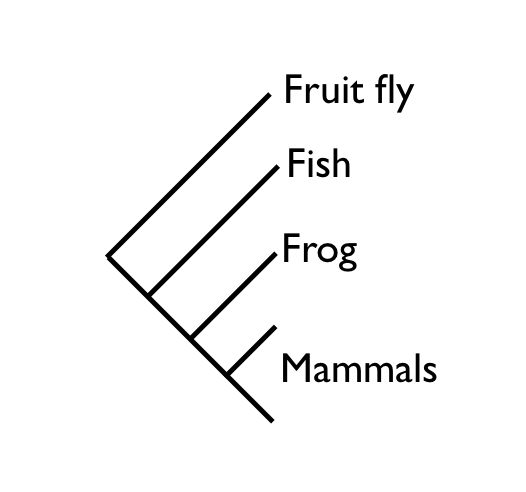
There are two additional errors, which are not as easy to detect but can be seen if all the taxa are compared using NCBI Taxonomy's "Common Tree" function (see illustration below).
First, the group of Human+Macaque is placed as a sister group to Pig+Whale, which is not correct. Human+Macaque should have been a sister group to Rat+Mouse, since primates and rodents belong together in the group Euarchontoglires.
Second, yeast is placed further from the animals than the plants are — that is also not correct. Yeast (and indeed all Fungi) actually belong together with the animals in the group Opisthokonta.
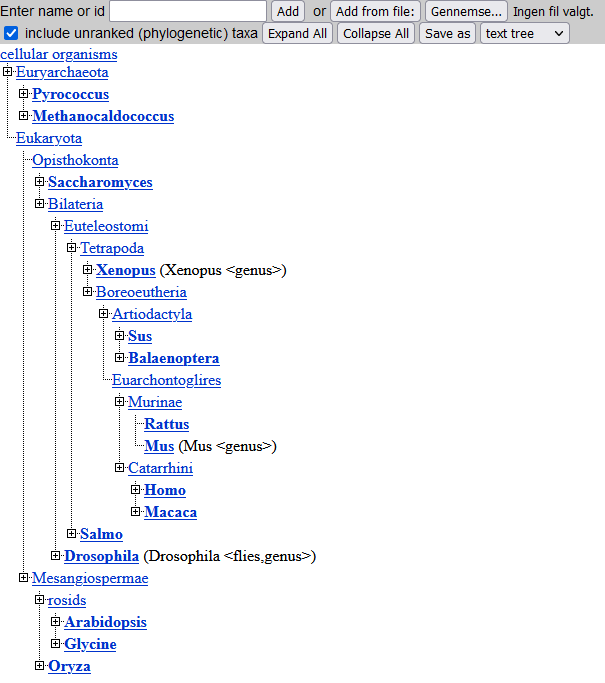
It is often seen that a phylogeny based on a single gene differs from the real phylogeny of the species. There are a number of reasons for why this happens, but one important one is simply the stochastic nature of mutations: Occasionally a gene will be most similar to the gene from a non-sister species, for entirely random reasons. This phenomenon tends to disappear as more sequence data is included in the analysis (the law of large numbers).
Step 9
- 54 results.
Search string: (protein_name:"ribosomal protein l3") AND (taxonomy_id:2759) AND (fragment:false) AND (reviewed:true) - 8 and 27 results, respectively.
Search strings: (protein_name:"ribosomal protein l3") AND (taxonomy_id:2759) AND (fragment:false) AND (reviewed:true) AND (cc_scl_term:SL-0173)
and (protein_name:"ribosomal protein l3") AND (taxonomy_id:2759) AND (fragment:false) AND (reviewed:true) AND (cc_scl_term:SL-0086)
Under the Download tab in UniProt, select "Download all", "FASTA (canonical)" and "Uncompressed". - Then use a plain text editor to combine them. Combined FASTA file is here: Ribosomal_proteins_35.fasta.txt
Step 10
Open the FASTA file with the 35 ribosomal protein sequences in Seaview, make sure Alignment options is set to "clustalo", and align all sequences. Then make an NJ tree (with Ignore all gap sites unchecked) and change the view to "circular".
Here is the result:
And here is the unrooted Newick tree file.
Step 11
Here is the rerooted tree made by Seaview:
Step 12
Here is the annotated tree, with blue circles marking the most recent common ancestor of human and yeast, and the green circles marking the most recent common ancestor of human and mouse:
Step 13
- The mitochondrial proteins are more closely related to each other than to their respective cytoplasmic counterparts. This could indicate that mitochondria have appeared only once in evolution.
- There are two differences: In the mitochondria, Bovine (cow) is the sister group to Human, while in the cytoplasmic proteins, Mouse+Rat comprise the sister group to Human+Macaque. Also, in the mitochondria, Yeast branches out before Arabidopsis on the way to Human, while in the cytoplasmic proteins, the plants including Arabidopsis branch out (slightly) before the fungi including Yeast. In both aspects, the cytoplasmic tree is more correct.
- There are more mutations per time unit in the mitochondrial part of the tree. This is evident from the fact that the horizontal distance between the blue and the green circle is larger in the mitochondrial subtree (by approximately a factor 2). Note that the two blue circles represent the same time point in evolutionary history, as do the two green circles. Note also that the branch lengths are proportional to the number of substitutions (accepted mutations).
